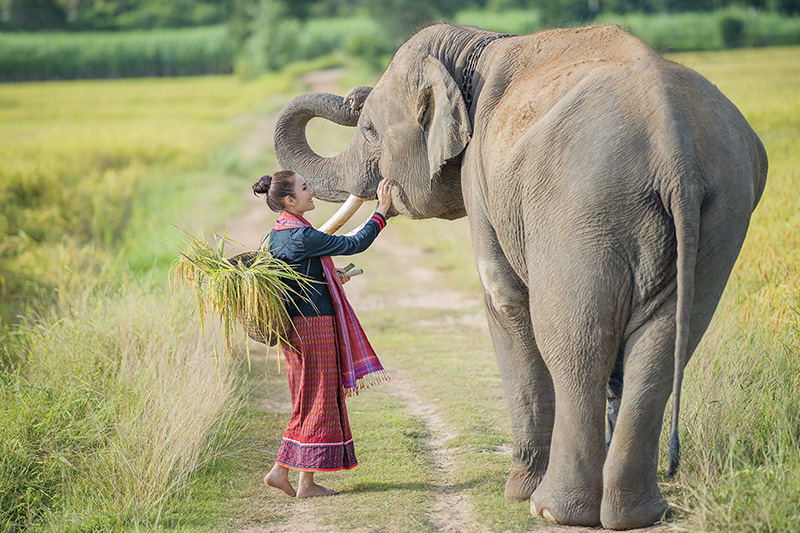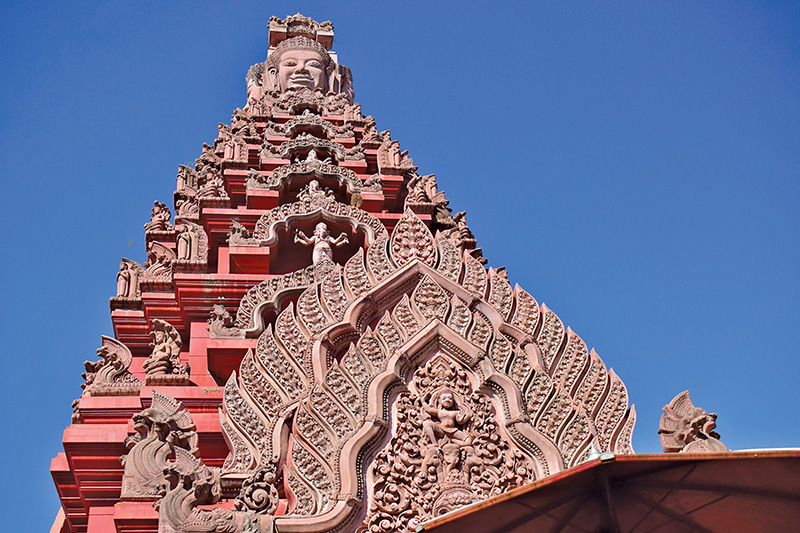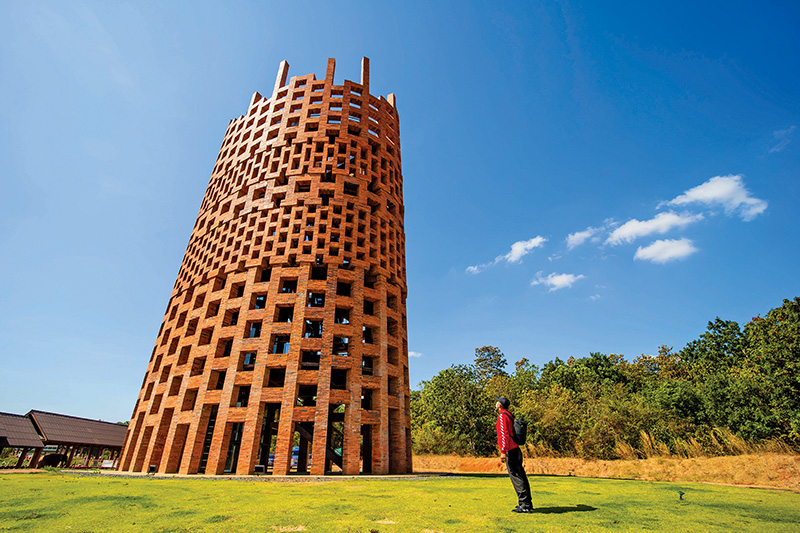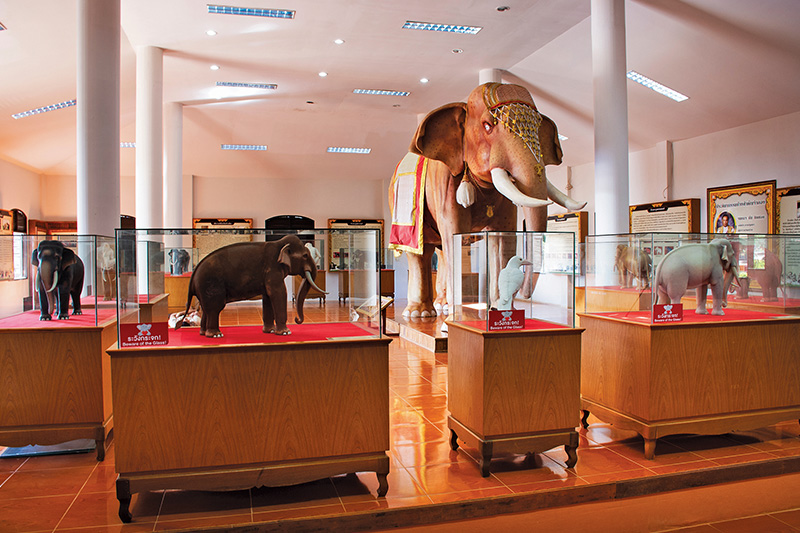
Surin: Land of Empires and Elephants
Hop aboard for a ride through the Khmer Empire, still whispering its stories in this quiet corner of northeast Thailand
Words: Phoowadon Duangmee
Photos: Shutterstock
At first light, Surin seems to emerge from the mist, magically reborn. In this quiet corner of Thailand’s Northeast, mahouts and young children sway through rice paddies on the backs of elephants, their outlines blurred by dawn’s soft glow. Ancient temples scattered around the province tell stories of forgotten gods in stones worn smooth by centuries of monsoon rain and summer heat. Across sunlit villages, the clack of wooden looms rings out as nimble fingers weave gold-threaded silk – just as their ancestors did long ago.
Usually bypassed by tourists drawn by Thailand’s famous beaches and royal cities, Surin boasts some of the nation’s deepest roots – preserved in sacred stones, gentle rivers, traditional crafts, and a deep connection with the land.
The province’s own roots stretch back more than 2,000 years. Once part of the ancient Khmer Empire, its history is interwoven with the grandeur of Angkor. Ruined temples and palaces still dot the countryside, the last remnants of once-powerful city-states.
When the Khmer kingdom faded into history, the land grew silent – until the Kui (Suai) people arrived in the 18th century. Renowned for their extraordinary bond with elephants, they crossed the Mekong to settle here, earning royal favour by capturing a prized white elephant for the Ayutthaya court. In 1763, their leader Luang Surin Phakdi decided to move his town to a more prosperous and defendable location. In recognition of his service and loyalty, Ayutthaya’s king named the new town after him: Surin. Today, elephants still set the rhythm of life in Surin, as surely as the monsoon rains shape the rice fields.

Spirit and Stone
At the heart of Surin stands the City Pilar Shrine, a guardian of the city’s spirit. This three-metre-tall totem, carved from Chaiyaphruek wood, embodies the city’s beating heart and is the best place to start your journey of discovery. A few steps away, the bronze statue of Phraya Surin Phakdi Si Narong Changwang keeps watch over his territory with a sword slung across his back and elephant goad in hand.
For your first stop, we recommend Wat Burapharam, home of the revered Luang Pho Phra Chi, an ancient Buddha image crafted in the Khmer style. Here, monks once received oaths of allegiance to the city’s founder, and to this day, locals seek blessings and protection here.
Just to the south, at Wat Pa Achiang, the profound bond between humans and elephants is honoured in a solemn display. In its Elephant Graveyard, over 200 of these majestic beings rest beneath sculpted palm-leaf tombstones – a tribute to their status as kin, not merely creatures.
For an eagle’s-eye view of Surin, Phanom Sawai Forest Park offers treks to three sacred peaks: Phanom Phrao (Khao Chai), crowned by a towering white Buddha, Phanom Sarai (Khao Ying), with ancient ponds of sacred turtles, and Phanom Kron, home to a replica Buddha’s footprint. From these summits, Surin’s gentle landscape unfolds like a prayer.

Echoes of Empire
Scattered across Surin are ancient stone relics of its Khmer heritage – a world of gods, warriors, and healers.
At Prasat Sikhoraphum, delicate carvings of Shiva, Vishnu, and dancing apsaras stare from weathered brick towers. Built as a Hindu temple and later converted for Buddhist worship, it reflects the centuries-long flow of religious currents through Southeast Asia.
Hidden deeper in the countryside, Prasat Phum Pon and the Ta Muen temple complex reveal the evolution of Khmer architecture – sanctuaries that became healing centres under King Jayavarman VII. At Prasat Hin Ban Phluang, a quiet yet intricate sanctuary, bas-reliefs of Krishna and Indra are framed by curling lotus garlands and elephants, connecting celestial myths with the earthbound creatures that still roam the area today.
However, Surin’s heritage is not confined to ruins; it still flourishes in the hands of artisans. In Ban Tha Sawang village, weavers crouch in earthen pits, manipulating hundreds of loom strings to create shimmering gold brocade once reserved for royal courts. Here, each inch of fabric takes days to weave – a meditation on patience and beauty.
Nearby in Ban Sawai and Ban Pho Kong, traditional silk weaving incorporates age-old motifs drawn from the landscape: the bold elephant and the delicate eggplant flower. Visitors are invited to dye silk, harvest organic vegetables, and share meals featuring river fish flavoured with local herbs.
In Khwao Sinarin village, the tap- tap-tap of silver hammers echoes across courtyards. Craftspeople shape Luk Prakuem – silver beads embossed with lotus and flame patterns – into necklaces and belts that marry ancient designs with modern elegance.

Heart of Thailand
In Ban Ta Klang, elephants are not just a spectacle – they are family. For centuries, the Kui people ventured into Cambodia’s forests to capture and train wild elephants, a tradition born of necessity and reverence. Today, the relationship has shifted towards conservation and dignity.
At Elephant World, visitors can watch these gentle giants paint, dance, and engage in playful games – skills learned through trust, not violence. More profoundly, the Elephant Kingdom Initiative, inspired by Her Majesty Queen Sirikit The Queen Mother, provides a vast sanctuary where over 170 elephants live free from exploitation, offering a model of ethical stewardship.
Everyday stories of mahouts sleeping beside their elephants, and elders recalling the great elephant roundups, reveal Surin’s enduring, adaptable, deeply tender spirit.
Surin’s countryside also sways to the quiet rhythm of seasons. At Satom Organic Farm, tucked along the Chi River, rice cultivation is more than a livelihood – it’s a ceremony. Visitors can learn to plant, harvest and make sato rice wine – joining a cycle that binds earth, water and community.
As the Huai Saneng Reservoir turns gold under the rising sun, locals jog, cycle, or simply breathe in the morning mist – a reminder that nature is both sanctuary and sustenance in Surin.
To understand Surin fully, you have to visit its National Museum. Here, lintels salvaged from Khmer ruins, finely spun silks, and silver heirlooms come together to chart the province’s journey – through nature, empire, colonisation, and community life. The elephant villages and marketplaces recreated within its walls remind visitors that Surin’s heritage is not dusty history – it is lived, celebrated, and protected even today.
Surin’s strength also lies in its diversity. Kui mahouts, Khmer artisans, Lao farmers, and Thai-Khorat merchants have blended their cultures for generations, shaping a province of intertwining traditions. Performances of Reamker (the Khmer Ramayana), vibrant Kantrum folk music, and communal rituals reflect a harmony born not of uniformity, but of a shared and richly layered history.
Surin’s identity is also savoured in its culinary favourites – river fish under layers of herbs, and fragrant jasmine rice steamed in banana leaves.
The local jasmine rice, prized for its soft texture and floral aroma, is more than a staple – it’s a symbol of local pride and deep tradition. Grown in rain-fed paddies using age-old methods, it captuers the spirit of the land.
Surin lies in the heart of the Isaan region, famed for its Thai culinary gems like Som Tam (Spicy Papaya Salad) and Laab (Minced Meat Salad). But among its unsung treasures is Nam Phrik Jarua Dong – a creamy, coconut-based chilli dip, rooted in Khmer cooking tradition. This intensely savoury relish is best enjoyed with crisp vegetables and steamed jasmine rice – even global icon Lisa of BLACKPINK is a fan.
Visitors to Surin step into a living memory, where carved lintels tell of empires past, silk threads shimmer with ancestral pride, and elephant trails etch devotion into the soil. Listen closely and you can hear this land speak – through the gentle rumble of elephant steps, the whisper of wind through rice paddies, and the rhythmic clatter of looms at work.

In Surin, Every day is Elephant Day
August 12 may be World Elephant Day – a global call to protect and cherish these gentle giants – but in Surin, that call has echoed for centuries. Here, among the paddy fifields and forest-fringed villages, tities between humans and elephants run deep. For the Kui people, who settttled here centuries ago, elephants are neither performers nor pets – they’re family.
In Ban Ta Klang and beyond, this ancient bond has shaped a new model of care. Inspired by Her Majesty Queen Sirikit The Queen Mother, projects like Elephant World and the Elephant Kingdom Inititiatitive provide humane, natural sanctuaries where elephants can roam freely and live well. Far from the spectacle of street parades, these inititiatitives are a quiet revolutition in conservatition – where traditition meets ethical progress.
However, if you are lucky enough to visit Surin on World Elephant Day, be ready to sway along in a vast celebratition of its beloved giants.
